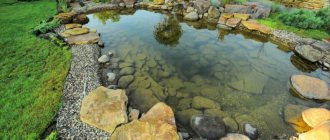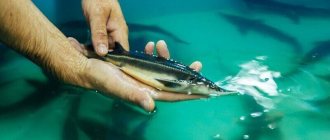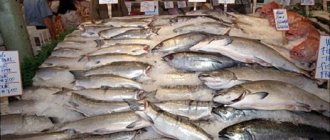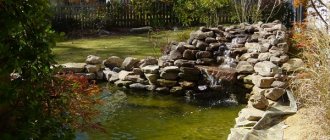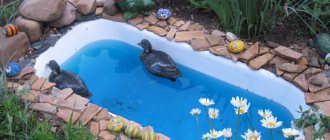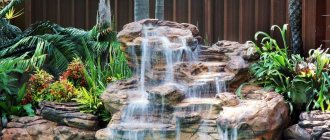Many owners of summer cottages are thinking about how to extract material benefit from the six acres they own. However, growing vegetables, fruits and berries requires constant care of the plants, and therefore citizens tired of their main work prefer less labor-intensive options for earning money. One of them is fish farming, which combines a hobby and the opportunity to earn income from selling carp and crucian carp to neighbors and friends. To do this, you need to figure out how to build a pond at your dacha for fish farming with your own hands.
Why build a pond at your dacha?
In summer cottages, the pond serves as a decoration of the landscape and a place for evening relaxation for the owners. However, many of them, being fans of fishing rods and spinning rods, are not limited to dreams of how to open a fishing store from scratch, but are trying to take real steps in organizing their own fish farming. There are many options for this matter, since they grow well even in small bodies of water:
- Carps. They are undemanding in terms of feed composition and are adapted for growing in warm water. By the age of three they gain about 0.8–1.1 kg of live weight;
- Crucian carp. They are distinguished by their tolerance to water quality and oxygen concentration in it. They prefer warm conditions and stop feeding at temperatures below 8°C;
- Silver carp. They quickly gain weight and have a small number of bones, and therefore often serve as raw materials in a business such as smoking fish;
- White amur. To maintain it you need pond plants and warm water. In good conditions, you can get specimens weighing 1.2 kg in a couple of years;
- Sturgeon. In this family, sterlet, paddlefish and bester are better suited for open ponds. They are tolerant of water composition and gain weight quickly;
- Peled. It is not afraid of cold water and an abundance of algae, and feeds even in winter. At two years it gains at least 700–800 g of weight and gets along well with carp;
- Catfish. Breeding catfish at home as a business is profitable due to their tolerance to water quality, friendliness and rapid growth;
- Trout. The most difficult fish for a beginner. It prefers cold, clean water from springs, and reaches a marketable weight of 700 g only in the third year.
Cultivation tank design
By using large tanks in conjunction with an advanced RAS management strategy, significant cost reductions and increased productivity in fish farming can be achieved. Growing fish in a small number of large tanks also contributes to a significant reduction in money and labor costs. According to practical experience, the effort required to maintain a container does not depend on its volume. Pools with a volume of 1 m3 or 100 m3 require equal amounts of time for monitoring water quality, adding feed and cleaning. In addition, the capital cost per pool unit decreases while its size increases. These benefits are, to some extent, offset by the challenges associated with large pools:
1. Creation of a water flow for uniform mixing and rapid sedimentation; 2. Sorting and collecting fish; 3. Removal of dead individuals; 4. Disabling the biofilter during chemotherapy; 5. There is a risk of large economic losses in the event of a violation of the integrity of the pool or biological problems.
The main problem is the risk of the basin collapsing, resulting in the loss of one cultivation tank. In this case, very large losses of fish are observed. However, as the fish farming team becomes more experienced in managing and designing systems, the risk of capacity loss decreases.
Large pools depend more on hydraulic calculations than small ones. In a container with a small volume (<1m3), the overall rate of water exchange is very high. Fast hydraulic exchange leads to improved water quality because more oxygen is brought into the container and contaminants are quickly removed. In large tanks, on the other hand, exchange times are low, so water inflow and outflow become key factors affecting the uniformity of water quality (regardless of the amount of feed introduced). In turn, the storage capacity of a reservoir is influenced by the rate of water exchange, the amount of feed introduced, oxygen consumption and the amount of pollutants produced (Losordo and Westers, 1994).
Containers used in fish farming vary in shape and water exchange characteristics (Wheaton, 1977; Piper et al., 1982; Klapsis and Burley, 1984; Cripps and Poxton, 1992). They are designed taking into account construction costs, footprint, and ease of monitoring water quality and fish. Currently, there is a tendency to use cylindrical tanks (>10 m) for fish rearing. They attract attention for the following reasons:
1. Easy to maintain; 2. Ensuring uniformity of water quality; 3. Allows you to work with different rates of water exchange to optimize living conditions and maintain fish health; 4. Sedimented particles can be quickly removed through the central bottom drainage; 5. The shape of the container is convenient for visualization and automation of monitoring of excess feed and, thus, allows you to control the saturation of fish.
In order to reduce labor costs for sorting and catching fish and water purification, it is necessary to create appropriate water supply and drainage systems, drainage and a collection tank.
The key feature of a cylindrical pool is its ability to self-clean. A pool diameter to depth ratio of 5:1 to 10:1 is recommended (Burrows and Chenoweth, 1955; Chenoweth et al., 1973; Larmoyeux et al., 1973); however, many farms use pools with a 3:1 diameter:depth ratio and cylindrical silos with a 1:3 ratio. Recent studies by the Norwegian hydraulic engineering laboratory SINTEF (Skybakmoen, 1989; Tvinnereim and Skybakmoen, 1989) have shown that the water inlet mechanism can be designed to minimize hydraulic problems in the basin. The choice of diameter:depth ratio greatly influences the size of the paddock, water pressure, stocking density, fish species, feeding regime and methods used. The depth of the container should also be selected for the convenience and safety of working with fish and water.
In a cylindrical basin, relatively uniform mixing can be achieved, i.e. the concentration of dissolved components in the water entering the container is instantly equalized to the concentration that exists throughout the entire volume. Therefore, with adequate mixing, all fish are located in water with the same composition. Good water quality can be maintained by optimizing the entry point and selecting the entry rate so that limiting water parameters do not reduce production once the system is filled with fish.
The rotation speed in the cultivation container should be as uniform as possible, from the walls to the center and from the surface to the bottom, and strong enough to realize self-cleaning. However, it should not exceed speeds that the fish can withstand. Its optimal values are on the order of 0.5-2.0 fish body length per second to maintain health, muscle tone and respiratory function of fish (Losordo and Westers, 1994). The velocities required to direct deposited particles into the bottom central drainage must be greater than 15-30 cm/s (Burrows and Chenoweth, 1970; Makinen et al., 1988). For tilapia, values of 20–30 cm/s have been suggested (Balarin and Haller, 1982). Timmons and Youngs (1991) developed a formula for calculating water rotation speed: Vsafe < 5.25/(L)0.37, where Vsafe is the maximum design speed (about 50% of the critical speed) in fish lengths per second, and L is fish body length (cm). In a cylindrical pool, the speeds decrease slightly from the walls to the center, which allows the fish to choose the most suitable current. This feature is completely unusual for channels where the speed is uniform throughout their entire length.
Is it legal to build a pond in a dacha?
Many novice entrepreneurs planning to set up a pond at their dacha for fish farming have doubts about the legality of such an enterprise. In fact, all the answers can be found in the regulatory documents:
- According to the Land Code, the owner on his plot has the right to build a pond and use it, observing sanitary and urban planning norms and rules;
- The Subsoil Law contains restrictions on the maximum depth of a fish pond, which is five meters from the surface of the earth;
- In addition, the construction and operation of the reservoir should not cause inconvenience to neighbors or cause flooding or subsidence in their territories;
- According to the Water Code, the pond and its contents belong to the owner of the site. You can arrange a recreation area or think about how to open private paid fishing;
- It is forbidden to dig up a reservoir if pipelines, communication lines or other utility networks in municipal property pass under the site.
Accordingly, no special permits are required for the construction or rental of a fish pond in a country house or on agricultural land. However, if filling it requires the construction of hydraulic structures on existing water bodies, the project will have to be agreed upon with the local administration and environmental service.
Types of fish ponds
Beginning entrepreneurs do not like to complicate their lives, and therefore, even when breeding fish in cages on ponds, they place all the individuals in one body of water. However, to control the reproduction process, development of fry and weight gain of commercial fish, it is recommended to use separate housing technology, which also makes possible regular drainage and maintenance of hydraulic structures. To implement such a scheme, the fish farm must include:
- Head Pond. This is a reservoir in which water from the source is heated and settled before being supplied to fish ponds. Fish are not grown in it;
- Mother ponds. Designed for separate keeping of breeding males and females, as well as replacement herds. They have a depth of 1.5–1.7 m;
- Spawning ponds. Shallow ponds with a bottom covered with soft grass. Males and females are placed in them for mating, and then larvae are obtained from the eggs;
- Nursery ponds. The fry obtained in spawning reservoirs are transferred and raised in them until autumn. They are distinguished by a large area and depth of 1.4–1.7 m;
- Feeding ponds. They are used to raise overwintered fingerlings to the stage of marketable fish. They are large in size and have a depth of 1.2–1.8 m;
- Wintering ponds. Small reservoirs with a depth of 2.2–2.5 m. They do not freeze in winter, and therefore are suitable for housing fish from November to March;
- Quarantine ponds. Designed for temporary keeping under supervision of individuals from other nurseries or with dangerous symptoms. Their depth is up to 1.5 m.
Stage-by-stage equipment of a concrete fish pond
At the place where the reservoir will be located, it is necessary to mark its outline ; for this, use stakes with a cord.
Now you can begin to extract the soil. You have already decided on the depth (don't forget to take into account the thickness of the concrete!), the sides need to be made at a slight slope (the angle should be approximately 20 degrees). Next, compact the bottom well. It is worth paying attention to its density; if it is too soft, then it needs to be strengthened with crushed stone. After this, you need to compact it again and add a layer of sand on top. Let's move on to pouring concrete. The proportion for the concrete mixture should be 1 part cement to 3 parts filler. Wooden beams are installed at the bottom, and a reinforcing mesh (with a wire diameter of 3-4 mm) is already attached to them. Before pouring concrete into the bottom, it is necessary to lay pipes for drainage and water inflow holes. When the concrete has hardened, we begin to create the formwork for the walls of the reservoir.
Ordinary boards are quite suitable for its manufacture. It is recommended to lay 10 cm layers of concrete mixture and compact them well. With this method, the pond will be quite durable and will last a long time. After approximately 2-2.5 weeks, the formwork should be dismantled and the walls should be plastered (a concrete mixture in a ratio of 1 to 3 is also suitable for this). The layer of plaster should be approximately 2-3 cm.
The use of a waterproofing additive as an additional material to the mixture will extend the life of the reservoir. Experts recommend not to neglect this advice.
How to choose a place for a pond?
Before starting construction work, it is advisable to carry out some research, since it will not be possible to dig a fish pond in the first place you come across.
When choosing a site for a pond, you must be guided by the following rules: 1. It is most convenient to build a pond in a shallow ravine or beam with gentle slopes and a longitudinal slope. A flat area of sufficient size is also suitable;
2. Any source of water should be located nearby. This could be a stream, river, large lake, spring or groundwater well;
3. It is most profitable to use areas with clay soils and loams. Chernozem promotes siltation, and sand or sandy loam requires waterproofing;
4. You cannot build ponds without waterproofing the slopes and bottom on acidic, salty and alkaline soils. These can release compounds hazardous to fish into the water;
5. The correct fish pond must be placed taking into account the size of the sanitary area. The distance to sources of pollution should be:
- To livestock and poultry complexes - 500 m;
- To railways and highways - 1200 m;
- To residential buildings and fertilized vegetable gardens - 300 m;
- Industrial enterprises are 500 m away.
6. To avoid flowering, the pond should not be constantly lit. The ideal period of direct sunlight is before 11 a.m. and after 4 p.m.;
7. It is not advisable to build a pond near trees and bushes. Their leaves will fall into the water and rot, and their roots will damage the waterproofing layer;
8. Unlike breeding grape snails, growing fish is impossible without electrical equipment. To connect it, there must be an electrical network nearby;
9. Finally, the pond should fit organically into the landscape and not cause problems for neighbors in the dacha area.
Preparing for winter and liming the pond
To organize a normal wintering of frost-resistant fish species in the pond, you need to prepare a place. Usually, an additional depression is built at the bottom of the reservoir - a wintering well. During the hibernation period it is covered with a wooden shield. The depth of such a well should be at least 2.7 m, but the area may be small, since the fish lose activity when cold weather sets in. In a state of suspended animation, most species are susceptible to attack by various parasites. For protection, it is necessary to lim the reservoir at the rate of 6 kg of lime per 50 m³ of water. The liming methods are as follows:
- You can manually add lime to the reservoir starting from the first spring feeding. It is simply sprayed over the water, hoping for uniform settling to the bottom.
- Sprinkling lime milk is also a common technique - lime is first dissolved in water and sprayed over the pond using a spray bottle.
- You can lime the pond after draining - use a cellular box from which lime is shaken out onto the surface of the sludge, evenly distributing it over the entire area.
Attention!
An excess of such a component leads to problems, as does its deficiency. With timely liming, the number of parasites and harmful bacteria in the water is reduced and calcium increases, which leads to more active development of fish.
Building a pond at your dacha with your own hands to grow and reproduce fish is not a difficult task. If you follow the technological process and first study the various instructions with photos, then all that remains is to prepare the ecosystem and plant the first individuals. When the process is already established, the fish pond will not take up extra time, but will bring additional income.
How to design a pond?
An artificial reservoir is a complex hydraulic structure, the reliability of which determines the success of fish farming in a pond as a business.
Since it consists of elements with different functions, design work should be carried out to determine their characteristics and relationships. What needs to be considered within their framework: 1. Before constructing a reservoir, it is necessary to choose its design. It is better to make a drainage pond that is more convenient to maintain. If this is not possible, you should level the bed and remove from it all objects that prevent fishing with nets;
2. The dimensions of the reservoir depend on the rate of water exchange and restoration of oxygen concentration. For example, the minimum size of a pond for breeding fish from the carp family should be 100–120 m², and for trout - from 180 m²;
3. To protect fish from overheating in summer and freezing of the reservoir in winter, the depth in the center should reach 1.5–1.8 m. However, in the hot southern and cold northern regions it is increased to 1.9–2.3 m without taking into account the thickness of the bottom layer silt;
4. The profile of the reservoir should be stepped or gradually deepening in order to be able to raise fry in shallow water and leave fish for wintering without transferring them to special ponds;
5. Zoning may look like this:
- Shallow water near the shore or along the perimeter, 1.5–2.0 m wide and 0.5–0.7 m deep;
- A step 1.2–1.8 m wide and 1.2–1.4 m deep for bottom plants;
- A wintering pit 1.8–2.2 m deep, accommodating all the inhabitants of the pond.
6. When constructing a fish pond, the minimum steepness of the slopes must be selected in accordance with the type of soil and the method of waterproofing. A reservoir made of clay or concrete may have vertical walls, but in sand such a bank will crumble;
7. Since the reservoir will have to be drained sooner or later, it is necessary to foresee in advance the slope of the bottom to the place of water discharge. At this point you need to install a bottom pipe with shut-off valves, a sluice valve or a siphon;
8. Water can be supplied to the fish pond through pipes or the same channels. They are laid with a slope that prevents silting, and are protected from debris and other fish entering the reservoir with grates and gravel filters;
9. At the bottom of the reservoir it is necessary to make furrows 0.5–0.7 m deep, which converge to a fish hole located near the spillway. Fish will be collected in it during drainage of the pond for scheduled fishing;
10. To prevent the pond from overflowing during rains or floods, an overflow must be made near the discharge point - a pipe or channel, the bottom of which is at the maximum water level in the reservoir. It is covered with a lattice or mesh to prevent the fish from escaping;
11. Construction of a fish pond also requires the construction of small pits for growing daphnia and brine shrimp - the main food of fry. One such pit 2 x 3 x 0.5 m is enough to provide a reservoir with an area of 100–200 m².
What kind of fish are bred in ponds?
It is not recommended to take fish from open and publicly accessible bodies of water - such representatives of aquatic fauna may be infected. When choosing a species for the development of suburban fish farming, you need to identify the goals of fish farming. Some varieties are suitable for eating, but others can create beauty. If you need fish only for aesthetic pleasure, then you should choose among the following species:
- Koya (Japanese carp) is a variegated fish with spots of gray, black and red. The required depth of the reservoir is from 2 m. You need to plant a lot of aquatic plants and feed them often, since this species is simply voracious. If you break the nutritional rules, there will be no algae or fry left in the pond.
- Goldfish is the most common species for ornamental cultivation. The color can be not only golden - when reaching a certain age, the scales can acquire whitish, orange and yellow shades. Goldfish reproduce very quickly, so large numbers of fish should not be released. Be sure to take them indoors for the winter.
- The minnow is a small colorful fish, up to 12.5 cm in size. The attractiveness of this species lies in its variegated color, the intensity of which intensifies during the spawning period. This species needs a lot of oxygen, so it is recommended to use an aerator. It is necessary to populate an artificial pond with many individuals at once, since minnows are more schooling fish.

If you plan to grow edible fish in a pond, then you need to take into account that most representatives love the extreme cleanliness of the reservoir and are demanding about its depth. It is imperative to monitor the composition of the water when introducing such species. The most common representatives of fauna for reproduction in an artificial reservoir for the purpose of catching as food are the following:
- Crucian carp is an undemanding fish that can be fed with any food. Up to 15 individuals can live peacefully in a small artificial pond. Certain temperature conditions are not necessary, nor is a high concentration of oxygen.
- Tench is a fish that rapidly gains weight over large areas of the reservoir. This species develops normally even with limited water aeration. But the main disadvantage of tench is its heat-loving nature - the indicators should not drop below 24ºC.
- Carp – under good conditions, this species develops rapidly. The pond does not need a special depth, but there cannot be more than 2 individuals per 0.5 m². One of the characteristics of this species is that individuals become accustomed to permanent feeding sites. When the temperature drops to 10ºC, the fish stop feeding.
On a note!
If there are concerns about the possibility of timely feeding of fish in the pond, then you can pay attention to pike perch, ruffe and goby. These species can remain for a long time without additional food, especially in the presence of living plants.
What materials should I use to build a pond?
When the pit is filled, water begins to filter—in other words, it simply soaks into the ground. In order not to find a completely dry reservoir after a week, this process must be suspended or stopped completely. There are two ways to build a fish pond:
- Reservoirs with a natural bed are used on dense soils made of loam or clay, which practically do not allow water to pass through. To equip them, you just need to dig a pit with gentle slopes and compact the soil;
- Reservoirs with an artificial bed are used on porous gravel, sandy loam and sandy soils that are not an obstacle to water. To install them, you have to lay a layer of waterproofing and pour bottom soil on top of it.
Depending on the project budget and the size of the reservoir, different waterproofing methods are used. All of them are quite reliable and, subject to construction technology, completely eliminate water loss:
- Clay. One of the most inexpensive options for arranging a fish pond with your own hands. The bed is lined with several layers of fine clay, each 15–20 cm thick, and pebbles or crushed stone are laid on top;
- Ready form. Factory-made plastic bowls are durable, resistant to frost and ultraviolet radiation. They are installed in pits with sand, combining pools to obtain reservoirs of various configurations;
- Concrete. The pit is covered with layers of sand and crushed stone, on top of which a mesh or reinforcing grid is laid. Next, the bottom and slopes are filled with a layer of concrete 20–25 cm thick using formwork. Reliable, but very expensive option;
- Polymer. The design is often used for breeding crucian carp in a pond at the dacha. The bed is lined with a sand cushion and then insulated with a PVC or HDPE film 1.0–1.5 mm thick. Its service life is 10–12 years;
- Butyl rubber. This elastic material is completely safe for fish and plants. Film sheets with a thickness of 1.2–1.5 mm and a width of up to 15 m are made from it, which is enough to insulate any pond. The construction principle is similar to the previous one;
- Propylene. Polypropylene sheets measuring 3 x 1.5 m and 3–6 mm thick are much stronger and more durable than any film. They line the pond bed on top of the sand cushion, welding or gluing together;
- Liquid rubber. This bitumen mastic can withstand frost down to -60°C and heat up to 50°C. It is sprayed in two or three layers onto geotextiles laid on a sand base. The service life of such a homemade fish pond is about 30 years.
Design of the water supply unit to the cylindrical pool
In a cylindrical pool, water flows tangentially to its walls (along the outer radius) so that the angular velocity of the water creates a rotational current towards the center. However, a number of studies (Burrows and Chenoweth, 1955; Larmoyeux et al., 1973; Wheaton, 1977; Skybakmoen, 1989; Tvinnereim and Skybakmoen, 1989; Paul et al., 1991; Goldsmith and Wang, 1993) note that adhesion, which exists between the primary flow and the bottom and walls of the container leads to the formation of a secondary radial flow directed from the walls to the center of the bottom, and from the center of the bottom to the surface. This flow carries the sedimented particles to the bottom drainage and thus generates the desired self-cleaning effect of the pool. Unfortunately, in a cylindrical container with such a flow, the roller-shaped area near the central drain acquires a very low rotation speed and does not mix well. The dimensions of this “dead” zone depend on the characteristics of the water inlet node (tangential to the walls), the “diameter: depth” ratio and the overall speed of the flow leaving the central drainage. Because the dead zone has low water velocity and is poorly mixed, it can reduce the efficiency of cultivation capacity by creating short, closed flows, local gradients of varying water values (especially dissolved oxygen concentrations), and static areas where sediment can accumulate.

The direction of the secondary radial flow is shown in the basin, as well as specific areas of the water mass
The self-cleaning effect is related to the overall flow rate leaving the central drain. In addition, removal of sedimented particles also depends on the ability of the fish to disturb the sediment. This explains the fact that in a tank with a higher stocking density of fish, self-cleaning is better than in a tank with a low stocking density. Since sedimented particles in fish farming have a specific density that is relatively close to the density of water (1.05-1.2 versus 1.0 for water; Chen et al., 1993; Potter, 1997), the slope of the bottom plane towards the central drainage does not improve self-cleaning ability. The inclined bottom is convenient only in cases of draining the pool when cleaning it.
The rotation speed can be controlled by creating specific water supply units. This allows the creation of a current adequate for fish (Klapsis and Burley, 1984; Skybakmoen, 1989; Tvinnereim and Skybakmoen, 1989). Tvinnereim and Skybakmoen (1989) reported that the speed of flow in a pool can be controlled by changing the force impulse (Fi):
Fi = ρ • Q • (νorif - νrota), where ρ is the density of water (kg/m3), Q is the speed of the incoming flow (m3/s), νorif is the speed through the water outlet unit into the container (holes or slots) (m /s), νrota – rotation speed in the pool (m/s). The momentum at the water inlet is mostly dissipated because it creates turbulence and rotation in the rotation zone. The force impulse, and therefore the speed of rotation in the tank, can be adjusted by adjusting the speed of the incoming water flow or the size/number of holes in the water inlet assembly (Tvinnereim and Skybakmoen, 1989). In his work, Paul (Paul et al., 1991) noted that the rotation speed in the container is roughly proportional to the speed of water through the openings of the inlet node, especially near the walls:
νrota ≈ α • νorif, where α is a constant of proportionality, generally equal to 0.15-0.20 (personal observations of A. Skybakmoen, AGA AB, Lidingö, Sweden), depending on the design of the water inlet unit. The flow pattern is influenced by: 1. the uniformity of water velocity throughout the container, 2. the strength of the secondary radial flow along the bottom of the container towards the central drain (i.e., the ability to move sediment into the drain), and 3. the uniformity of water mixing. Skybakmoen (1989) and Tvinnereim and Skybakmoen (1989) compared tank hydraulics, which occurs when water enters tangentially along the outer radius of the pool, with systems such as:
1. traditional open pipe; 2. a short, horizontal, submerged pipe, the axis of which is directed towards the center of the pool. At a distance from the end of the pipe along its entire length there are holes (60 cm below the surface of the water); 3. a vertical, submerged distribution pipe with holes along its entire length; 4. a pipe that combines vertical and horizontal branches.
Pipe for water supply, combining vertical and horizontal branches
The authors noted that an open-ended pipe produces non-uniform velocity throughout the container (i.e., higher velocity near the walls); provides poor mixing in the dead zone, which is caused by the formation of short closed flows; Throughout the entire depth of the pool, sediment becomes agitated and is poorly washed off from the bottom. Regarding the horizontal orientation of the submerged pipe, they noted good mixing and exchange of water throughout the volume, but weak and less stable flow at the bottom (to wash away sediment). The vertical orientation of the submerged pipe gave better self-cleaning quality than in the case of an open pipe or horizontal orientation, but the resulting strong current at the bottom (responsible for removing sediment) also led to poor mixing in the dead zone and small circulations, which worsened the time of complete water exchange. The authors proposed organizing a combined design with horizontal and vertical immersed pipes. The vertical branch is located at some distance from the wall so that the fish can pass between the pipe and the wall. This method provides several advantages: 1. homogeneous mixing is achieved; 2. the formation of small water cycles is prevented; 3. the same speed is created at depth and along the perimeter of the pool; 4. Sedimented particles are effectively transferred from the bottom to the central drainage.
For large cylindrical pools with a diameter >6 meters, numerous distribution pipes are installed around the perimeter. This improves sediment removal, uniformity of mixing speed and water quality (Klapsis and Burley, 1985). However, water supply pipes make it difficult to work with fish. This problem can be solved by incorporating holes into the pool wall as in the case of cross-flow tanks (Watten and Johnson, 1990). Unfortunately, from an economic point of view, this “elegant” solution may not be practical. In addition, such insertion of holes and slots involves the creation of flows parallel to the wall and may not provide as good flow distribution as is possible when installing a vertical pipe away from the wall. It is necessary to create a water supply system that would be removed during fish collection or stocking, or the collection device must operate in the presence of pipes.
How to organize water supply for a pond?
The exchange of water in a pond is the main condition for maintaining its quality, and for different types of fish there are different standards for the rate of renewal. For example, in a business such as sterlet breeding, it is necessary to provide a supply of at least 0.75 l/h per square meter of area. If the water supply source does not allow the construction of a flowing reservoir, additional water purification will have to be done. There are several designs of ponds, differing in the filling method:
- Key Pond. Filled with water from springs or springs. Thanks to its constant supply, the reservoir can be made flowing and adapted for growing cold-loving fish species;
- Brook Pond. It feeds from a small river or stream. To build it, depending on the type of landscape, you need to block off the beam of the reservoir with a dam and install a drainage in it, or dig a pit in the floodplain. The water here is usually warm;
- Flood pond. Fills with water when snow melts or precipitation falls. Since the supply of water is limited, it is intensively filtered, and the reservoir, in comparison with ordinary ponds, is further deepened in case of drought;
- Ground pond. If the groundwater level is high, you can simply make a pit 2.2–2.5 m deep and level its bed. Of course, it will not be possible to drain such a pond completely, and the water level in it will depend on external factors;
- An embanked pond. Similar to a dirt road, but built along the river near the shore. To do this, either dig a pit or build dams along the perimeter of the reservoir. Water enters it through one channel and flows out of another;
- Fillable pond. A small reservoir can be built even far from sources, if it is filled from a well or water supply. Of course, draining all the water from it is uneconomical, and refilling it is very time-consuming and expensive.
Structure of water outflow in a cylindrical basin
In cylindrical fish culture tanks, the settling particles, i.e. feces, introduced and uneaten food settle at the bottom. The sediment is continuously removed through a central pipe. To also control the water level, it is necessary to have two concentric pipes. Perforations (Larmoyeux et al., 1973) or slots (Surber, 1933) at the base of the outer pipe allow sediment to escape from the bottom, and the inner pipe is used to set the water level. Surber (1933, 1936) developed a central drain riser for self-cleaning pools and recommended creating an adjustable gap between the bottom of the outer pipe and the bottom of the tank to enhance suction as the water flow leaves the bottom of the pool where sediment accumulates. The distance between two pipes, i.e. the annular space must be selected to create a sufficient water flow velocity (0.3-1.0 m/s, depending on the size and density of the particles) so that it carries sediment along with it up to the top of the inner pipe. Wheaton (1977) reported that the use of a central drain riser in large cylindrical basins with strong radial flow can result in rapid rise of water, which carries sediment into the central pipe. This problem can be solved by using a water drain and an external drain riser.
When the water level is controlled by an external standpipe, the bottom center drain can be covered with a perforated plate or mesh. This will allow sedimented particles, but not fish, to leave the pool (Piper et al., 1982; Skybakmoen, 1989; Tvinnereim and Skybakmoen, 1989). Another patented method uses ring-shaped proximity plates to enhance particle capture (Lunde et al., 1997). Similarly, solids are removed from the culture vessel through an annular slot formed by the basin bottom and a vertical pipe (scheme similar to Surber, 1933, 1936), with the water level controlled by an external drain riser (Josse et al., 1989).
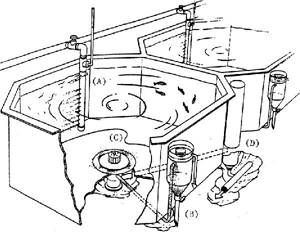
The bottom drainage is covered with a rigid plate. Shown is the water inlet mechanism (A), external centrifugal separator (B), second bottom drain (just above the first bottom drain, C), external drain riser (D) (AquaOptima AS)
| Hole size(mm) | Fish size (g) |
| 1.6 x 3.2 | fry - 0.45 |
| 3.2 x 6.4 | 0.45–2.3 |
| 6.4 x 12.7 | 2.3–15 |
| 12.7 x 19.1 | >15 |
Corrosion-resistant material such as perforated sheets of aluminum, stainless steel, fiberglass or plastic is used to cover the bottom drain (Piper et al., 1982; Sedgwick, 1985). Some studies recommend horizontal slots in cover plates instead of holes, which have a larger open area, are less likely to clog, and are easier to clean (Piper et al., 1982; Pankratz, 1995). In particular, Piper (Piper et al., 1982) advised selecting the size of the slots based on the length of the fish being bred. The ideal option is a slot size that prevents fish from being sucked in, but allows sediment to pass through easily. Fish getting stuck usually occurs when velocities are too high in the central drainage area. These cases can be minimized by keeping the drain flow rate <30 cm/s. Depending on the species and life cycle stage, particularly during the juvenile stage, low velocities of <15 cm/s are required (Pankratz, 1995). These speeds do not create high suction force, so the fish will not hit the drain.
Not all fish species require a grill to prevent them from being sucked in. Thus, salmon reared in tanks with a diameter of 4.9-9.1 meters never pass into the drain (S. Wilton, PRA Manufacturing, Nanaimo, BC, personal observations). In this regard, the design may have a non-mesh bottom drainage, an external drain riser to control the water level, a screen to catch dead fish and external drainage. According to Wilton (personal observation), salmon are not sucked into the drain because they swim upstream against the current.
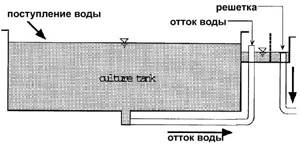
The bottom drain without a protective mesh is connected to the outer chamber of the drain riser, which includes a weir to control the water level in the pool and a grid to retain dead fish. The container can be equipped with a wall drain and thus cleaned using the principle of centrifugal separation.
How to drain water from a pond?
As practice shows, digging a pond for fish breeding is not difficult if you have the appropriate equipment. But this structure may turn out to be useless if the technology for draining it for fishing and repair is not immediately thought through. There are several solutions suitable for a summer cottage:
- When supplying water at low speed, drain through a pipe. It is buried in the deepest place of the pond near the dam and placed on a concrete slab 6–10 cm thick. The drainage channel is strengthened against erosion with brick or crushed stone;
- For large volumes of incoming water, a panel drain is required. The shutter is assembled from thick oak boards and lifted by the hinges with cables using a gate. The soil at the drain site is also protected from erosion;
- If it is impossible to drain water from the bottom, install a siphon drain. It looks like a pipe with taps thrown across the dam surrounding the pond. One end of it is immersed in water, and the other is brought out into the adjacent territory;
- A pumping unit is used if the reservoir is located below ground level. Its productivity should be quite high, since even a small pond can hold hundreds of tons of water.
It is most convenient to drain the pond into a nearby natural body of water - a river or lake. If a large volume of water does not erode the soil and cause it to become waterlogged, a neighboring ravine can be used. Otherwise, you need to look for other options:
- The pond can be drained directly onto a sufficiently large area if the soil on it absorbs water well and is not subject to erosion;
- You can use regular sewerage if the drain is not noticed by utilities. But at dachas it is usually replaced by a septic tank, which cannot cope with the load;
- Having a storm drain nearby is a good option. It is made of large diameter pipes and easily passes large volumes of water.
How to build a fish pond?
Technologies for arranging artificial reservoirs may have some differences at the stage of laying waterproofing, but the general procedure for carrying out the work remains unchanged in any case. Here is an example of how to build a fish pond step by step from polyethylene or butyl rubber film - due to their low price and ease of processing, they are most often used in summer cottages:
- The construction site is cleared of debris, stones, trees and bushes. Using dry sand, the contours of the future reservoir are marked on it;
- They start digging the pond from the middle so as not to collapse the edges. In the shallow area at a depth of 50–60 cm, a step a couple of meters wide is left for planting plants;
- The pit is built half a meter deeper than the planned size. This is necessary to arrange the bed and compensate for siltation in the future;
- At the end of the soil sampling, the walls and bottom are checked for the presence of stones, roots and other foreign objects that could damage the waterproofing;
- The bottom and slopes are leveled with a layer of wet sand 15–20 cm thick, which is thoroughly compacted after laying;
- At the point where the water is discharged, a pipe covered with a metal mesh is laid. Next to it, a trench half a meter deep is dug to collect fish;
- To protect the waterproofing coating from damage by stones, roots and underground animals, the bed is covered with fiberglass or geotextile;
- After measuring the length and width of the pond, taking into account the slope, cut off the appropriate piece of insulation. If it is not enough, the canvases are welded or glued;
- The film is straightened at the bottom of the reservoir, and the edges are placed in a groove dug around the perimeter and pressed with stones;
- The pond bed is covered with smooth stones, pebbles and soil on top of the film so that plants and microorganisms can establish themselves here;
- Upon completion of the work, the home fish pond is filled with water. After 3–5 days, when the soil settles and the film is leveled, its excess is cut off;
- At this time, the water level is constantly checked. 1–2 cm per day are a consequence of evaporation, but a large runoff makes it necessary to look for damage to the insulation;
- To protect the reservoir from the flow of dirty and melt water, a safety embankment 30 cm high and 60 cm wide is installed around it at a distance of 2–3 m;
- The first fill is necessary to flush the pond. After a week it is lowered, after which the water is finally filled in;
- Stocking of a pond in a fish breeding area is carried out after another 10 days, when sand has settled from the water and harmful compounds have evaporated.
Conditions for fish farming
Many pond inhabitants are quite sensitive to changes in the composition or temperature of the water. For example, crab farming as a business generally becomes impossible if its hardness is at least 10% higher than the recommended one. Therefore, before starting construction of a reservoir, it is recommended to examine the water from the source and evaluate its suitability for keeping certain types of fish. What parameters are important:
- Water acidity may change during winter or algal blooms. A significant decrease or increase in it provokes the death of fish;
- When the oxygen concentration in the water drops below 70%, the fish begins to suffocate. At the same time, increasing it to 150–180% does not entail any unpleasant consequences;
- Carbon dioxide is released by living organisms and appears during the decomposition of organic matter. 30 mg/l causes anxiety in fish, and 120 mg/l causes poisoning;
- Ammonia enters water with fertilizers from fields or when plants rot. Its high concentration prevents the uptake of oxygen by hemoglobin;
- Nitrites indicate contamination of the reservoir with chemicals and organic oxidation products. Cause the destruction of red blood cells and the development of diseases;
- Nitrates appear from nitrates, are released by bacteria, or also enter the pond from fields. Suppress fish growth and reduce its reproductive functions;
- Phosphates interfere with the development of phytoplankton, which is the main food for fry. They get into the pond with food or fertilizers;
- Iron in ferrous form provokes the appearance of bacteria on the gills of fish. In addition, it binds oxygen dissolved in water.
Numerous experiments have allowed specialists to establish acceptable limits for the concentration of impurities in water intended for growing freshwater fish:
Pond water supply requirements
| Parameter | For carp | For trout | Winter | Spawning |
| Temperature, °C | up to 28 | up to 20 | up to 8 | 10–20 |
| Difference with source, °C | up to 5 | up to 5 | until 3 | up to 5 |
| Smell and taste | No | No | No | No |
| Transparency, m | 0,7–1,0 | 1,5 | 1,5 | 2,0 |
| Insoluble residue, g/m³ | 25,0 | 10,0 | 10,0 | 5,0 |
| Acidity, pH | 6,5–8,5 | 7,0–8,0 | 7,0-8,0 | 7,0–8,0 |
| Oxygen, g/m³ | 5,0 | 9,0 | 6,0 | 9,0–12,0 |
| Carbon dioxide, g/m³ | 25,0 | 10,0 | 15,0 | 10,0 |
| Hydrogen sulfide, g/m³ | 0,0 | 0,0 | 0,0 | 0,0 |
| Ammonia, g/m³ | 0,05 | 0,05 | 0,05 | 0,01 |
| Ammonium, g/m³ | 1,0 | 0,5 | 1,0 | 0,75 |
| Nitrites, g/m³ | 0,02 | 0,02 | 0,005 | 0,02 |
| Nitrates, g/m³ | 2,0 | 1,0 | 0,005 | 1,0 |
| Phosphates, g/m³ | 0,5 | 0,3 | 0,05 | 0,05 |
| Total iron, g/m³ | 1,8 | 0,1 | 0,3 | 0,1 |
| Ferrous iron, g/m³ | 0,028 | 0,1 | 0,05 | No |
| Microorganisms, million/ml | 3,0 | 1,0 | 2,0 | 2,0 |
| Saprophytes, thousand/ml | 5,0 | 3,0 | 3,0 | 3,0 |
How to create an ecosystem in a pond?
Aquatic life is a living organism that cannot live and reproduce in sterile laboratory conditions. Even when growing shrimp at home, plants and algae are needed, and in an open pond without an ecosystem, the water will generally become unsuitable for keeping fish. When constructing country ponds, a multi-tiered landscaping method is usually used:
- At depths of 2–3 m, water lilies, water lilies, and pondweed develop well;
- At a depth of 0.8–1.6 m you can plant hornwort, salvinia, and water chestnut;
- Reeds, cattails and manna grass are grown in shallow waters;
- Duckweed, egg capsule, and marsh flower may float on the surface;
- Swampweed, elodea, and water moss are suitable for filling water with oxygen;
- On the banks for shading, it is worth planting calamus, swimweed, and sedge.
In reservoirs with an artificial bed, plants should be planted in canvas bags, plastic and clay pots. To prevent the soil from being washed out of the containers, it is covered with a layer of burlap and sprinkled with gravel. The natural bed allows plants to be planted directly on the bottom before the pit is filled with water.
Also, when setting up a fish pond with spring and spring water supply, it is useful to pour 30–40 liters of water into it from the nearest natural reservoir. It contains microorganisms, zooplankton and various algae that will multiply and contribute to the creation of an ecosystem familiar to fish.
Video on the topic
How to care for a pond at your dacha?
You cannot leave your dacha pond without maintenance, otherwise in just a couple of years it will turn into an overgrown swamp. It cannot be said that maintaining a fish pond requires significant effort, but certain work must be carried out regularly:
- All hydraulic structures are inspected monthly to identify breakdowns. During the next release of water, liming and ongoing repairs are carried out;
- After the snow melts, the surface of the pond is cleared of debris and dried plants. If the water begins to become cloudy with warming, the reservoir is partially drained and cleaned;
- Small reservoirs that were dry in winter are limed and filled with water. After the water has warmed up, plants are planted in them;
- Before the start of spring feeding of fish, an analysis of the composition of the water is carried out. If necessary, it is adjusted, restoring normal values;
- Flowering plants are mowed regularly in summer to prevent seed formation. Soft vegetation and duckweed are collected with a rake;
- Closer to autumn, the pond begins to be cleaned of fallen leaves every day. If there is a lot of it, a nylon mesh is stretched over the water;
- In the fall, all pond equipment is removed from the reservoir and repaired, water is drained from all auxiliary hoses and pipelines;
- On the eve of frost, a small artificial fish pond is completely drained. Large reservoirs are left with water for the winter;
- Before freezing, pieces of foam plastic, boards and floats are thrown into the water, which compensate for the pressure of the ice on the bowl of the pond;
- During severe frosts, the surface is covered with hay or straw so that the pond with wintering fish does not freeze to the bottom;
- To supply food, holes are drilled in the ice and covered with shields. Aeration of water for fish is carried out using compressors or oxidizers.
Types of ponds
Types depending on the method of water supply
- If there is a natural spring on the site, then this is simply a gift from nature. Place the pit below the spring, and the water will naturally replenish it with crystal spring water. Even noble fish can be grown in clean water: trout, whitefish.
- Another present is a stream flowing through the site or nearby. It can be blocked by building a small dam or dam. Typically, the water in such ponds is warm, and they are suitable for raising heat-loving fish. But there is also a pitfall: according to the Water Code of the Russian Federation, such a pond is “associated with water bodies.” For its construction it is necessary to obtain the appropriate permit. And also, an approved project for a hydraulic structure, which is a dam or dam.
- Excavated reservoirs filled with groundwater, rainwater, and flood water. It is possible to grow river fish in them: carp, crucian carp.
Device methods and materials
- Constructed with concrete base and walls. The most labor-intensive option, but also the longest-lasting structure.
- Plastic. It is not complicated in execution, but is limited in size and therefore suitable for growing ornamental fish.
- A pond where PVC and butyl rubber film are used as waterproofing. It can be made in any size and shape. But the period of use will depend on the service life of the film.
- An unlined pond can be built in an area with high groundwater levels. Clay is placed on the bottom and walls. On the edges are cut layers of turf.
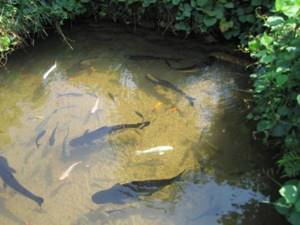
Fish farming equipment
Any agricultural activity requires the use of specific equipment - even breeding worms as a business will not bring profit if all the work is done manually. It is much more difficult to care for fish, since creating a comfortable environment for its growth first of all means improving the quality of the water. Fortunately, today there are the necessary devices for this:
- Mechanical filter. Filled with gravel, coarse sand or special granules. Flowing through it, water is cleared of insoluble sediment;
- Biological filter. Contains porous material on which bacteria live. They absorb organic residues, microorganisms and harmful substances from water;
- Skimmer. It is a filter floating on the surface. It traps debris and algae from the top layer of water;
- Ultraviolet sterilizer. Passes water through itself and destroys fungi, microorganisms, bacteria and other pathogens that enter the reservoir;
- Water vacuum cleaner. Designed to collect silt particles, food residues, leaves, small algae and fish waste products from the bottom;
- Aerator. A special disc made of porous material that sprays air coming from the compressor onto the bubbles, saturating the water with oxygen;
- Oxidizer. It decomposes hydrogen peroxide into water and oxygen, which also enters the reservoir. Used for installation at the bottom in wintering pits;
- Pump. It takes water from the pond and passes it through filters, creating a closed cycle. It is also used to drain or fill a reservoir.
Such equipment cannot handle industrial ponds with an area of tens of hectares, but it is much easier and more convenient to maintain a country pond of four to five acres with its help. Here's what an entrepreneur will need:
Fish pond equipment
| Name | price, rub. | Quantity, pcs. | Amount, rub. |
| Mechanical filter | 45200 | 1 | 45200 |
| Biological filter | 44200 | 1 | 44200 |
| Oxidizer | 19200 | 1 | 19200 |
| Aerator | 2200 | 4 | 8800 |
| Circulation pump | 5500 | 1 | 5500 |
| UV sterilizer | 42200 | 1 | 42200 |
| Compressor | 8100 | 1 | 8100 |
| Water vacuum cleaner | 13400 | 1 | 13400 |
| Skimmer | 52700 | 1 | 52700 |
| Bottom spit | 2500 | 1 | 2500 |
| Generator | 15000 | 1 | 15000 |
| Thermooximeter | 32000 | 1 | 32000 |
| Water test kit | 9500 | 1 | 9500 |
| Nets, buckets and other tools | 8000 | – | 8000 |
| Total: | 306300 | ||
Some important nuances
- hard-leaved plants used for decoration help prevent cloudiness and blooming of water. But they do not exclude the need to install filters and a supply system to improve water quality;
- to shade part of the reservoir, you can install an awning, this will protect against algal blooms and create favorable conditions for fish;
- it is advisable to construct a bottom of complex terrain with alternating deep and shallow areas;
- The best option would be gravel at the bottom of the pond.
Having weighed all the pros and cons, having analyzed our financial capabilities and physical strength, we begin to design and construct a fish-breeding reservoir.
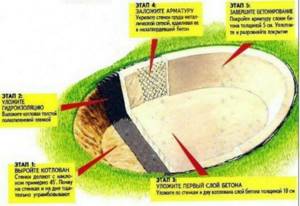
How much does a fish pond cost?
There is no universal estimate for the construction of an artificial reservoir, since in each specific case the amount of costs will depend on the nature of the soil, waterproofing technology, method of water supply and many other factors. However, to assess the scale of investment, you can calculate how much a fish pond with an area of 400 m² with a bed of plastic film costs:
Cost of a country pond
| Expenses | Amount, rub. |
| Permits | 10000 |
| Soil sampling | 60000 |
| Polyethylene film 1 mm | 64000 |
| Geotextile under film | 14000 |
| Arrangement of water intake | 25000 |
| Arrangement of the drainage system | 25000 |
| Plants | 6000 |
| Water analysis | 8000 |
| Equipment | 306300 |
| Total: | 518300 |
Photo tips for raising fish in a pond
Read here How to make a nest from branches: a step-by-step description of how to build a nest with your own hands and options for use in landscape design (100 photos)
Did you like the article?
0
